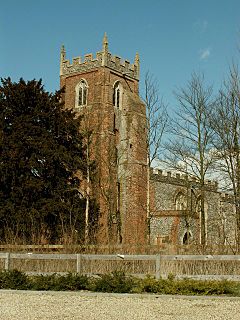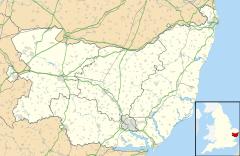Chilton, Suffolk facts for kids
Quick facts for kids Chilton |
|
|---|---|
 St. Mary's church, Chilton |
|
| Area | 3.49 km2 (1.35 sq mi) |
| Population | 367 (2011) |
| • Density | 105/km2 (270/sq mi) |
| OS grid reference | TL891429 |
| District | |
| Shire county | |
| Region | |
| Country | England |
| Sovereign state | United Kingdom |
| Post town | Sudbury |
| Postcode district | CO10 |
| EU Parliament | East of England |
Chilton is a small area located on the eastern edge of Sudbury in Suffolk, England. It's known as a civil parish, which is a type of local area with its own council.
Once, Chilton was a busy village. But today, it has only a few scattered houses and a quiet church called St. Mary's Church. It's a great example of what historians call a deserted medieval village, meaning a village that was left empty a long time ago.
Contents
Chilton's Ancient Past
Chilton has a very long history, going all the way back to the British Iron Age. This was a time when ancient Celtic people lived here and farmed the land. The name Chilton itself comes from Old English, an old form of the English language. It means "Child's Town".
The Domesday Book and Early Owners
In 1086, a very important book was created called the Domesday Book. It was like a big survey of England, ordered by William the Conqueror. This book recorded who owned what land. For Chilton, it showed that a man named Robert Malet was the main landowner. He was an important person in William the Conqueror's court.
Why Was Chilton Abandoned?
It's a bit of a mystery why Chilton became a deserted village. Historians have a few ideas:
- The Black Death: This terrible disease spread across Europe in the 1300s. It caused many people to die, and some villages were left empty.
- Land Changes: Another idea is that the land around Chilton Hall was changed. It was turned into a large deer park for hunting. This might have meant less land for farming and fewer reasons for people to live there.
- Farming Problems: Sometimes, if farming became difficult or less profitable, people would move away to find work elsewhere.
For a long time, only one house stood next to the church. Even though the church isn't used for regular services anymore, special services are still held there three times a year.
Chilton During World War II
During World War II, a large airfield was built mostly within Chilton's parish. It was first called Airfield 174, but later became known as RAF Sudbury.
RAF Sudbury Airfield
The airfield was finished in 1943. On March 23, 1944, it was given to the USAAF, which was the American air force at the time. The airfield had three runways and was home to the USAAF's 486th Bomber Group. This group is now known as the 486th Air Expeditionary Wing. Today, the large airplane hangars at the old airfield are mostly used to store grain.
Chilton Hall Today
Chilton Hall has a special connection to history. It was once home to the grandmother of Robert Walpole. He was a very important person because he became the first Prime Minister of Great Britain. Today, Chilton Hall is the home of Lord Hart of Chilton.


